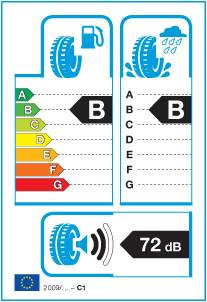|
European Commission Regulation 1222/2009 requires that all tyres* produced after June 2012 and on sale in the EU from November 2012 will either need to bear a sticker or be accompanied by a label to be displayed at the point of sale.
An example of the new EU Tyre Label can be seen to the right. This is similar to labelling already in wide use for household goods such as washing machines a nd dishwashers. nd dishwashers.
More information about the new tyre labelling regulations as well as a list of FAQs is available from the European Tyre & Rubber Manufacturers' Association (ETRMA).
Wet Grip
The most important role of a tyre is to provide safety - in all conditions. Wet adherence or grip is one of the most important performance characteristics.
However, higher adherence and lower rolling resistance are often contradictory objectives that have traditionally required a performance trade-off. Thanks to the new labelling regulation, customers will be able to see and choose for themselves their preferred performances.
The label will display a range of 7 grades where tyres with an “A” provide the highest levels of wet grip and “G” the lowest.
Fuel Efficiency
One of the forces influencing the fuel efficiency of a motorised vehicle is the Rolling Resistance of the tyres.
This phenomenon exists because a tyre deforms when rotating, resulting in energy losses in the form of heat. The higher the deformation, the higher the tyre rolling resistance, and consequently the more fuel required to move the vehicle forward. In other words, lower rolling resistance means lower fuel consumption and therefore lower vehicle emissions, including CO2.
The new label will display different grades in “rolling resistance” where A is the most “fuel efficient” and G the worst in class. The black arrow (in this case B) next to the grading indicates the performance level of the product.
Traffic Noise
Traffic noise is a relevant environmental issue, determined by:
• Traffic intensity and vehicle types
• Driving style
• Tyre-Road interaction
Exterior noise levels are split into 3 categories and measured in decibel (dB) in comparison with the new European tyre exterior noise levels to be introduced until 2016.
1 black sound wave = 3dB less than the future tighter European limit.
2 black sound waves = already compliant with the future European limit.
3 black sound waves = compliant with the current European limit.
The regulation aims at increasing the safety and the economic and environmental efficiency of road transport by promoting safe and fuel-efficient tyres with low noise levels. It also establishes a framework for the provision of harmonised information across the industry on some tyre parameters.
Such information will, at all times, be available for customers through technical promotional material, including the websites of the manufacturers. Some tyres are excluded, such as retreaded tyres, off-road tyres and racing tyres.
The expected cumulative benefits from the increased use of fuel efficient tyres will lead to saving up to 4 million tonnes of CO2 per year (depending on the speed of market transformation towards fuel efficient tyres) , and will also drive the market towards improved wet grip performance.
For more information call 01732 864 999
|